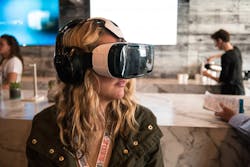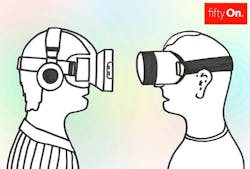How virtual and augmented reality can shape architecture and design
One of my colleagues recently shared a New York Times blog post by Strauss Zelnick, a Chief Executive and Chairman at Take-Two Interactive Software, the makers of the popular "Grand Theft Auto" video games. In the post, Zelnick is quoted saying he is “interested and cautious” about the potential of virtual reality, one of the oldest wearable technologies. The post went on to discuss how virtual reality still holds great potential for the entertainment industry, even though no one is really sure what the offering might look like.
This sort of scenario is unfolding across many industries: potential uses for virtual reality have everyone excited, but few people have a practical vision for what the development roadmap might look like. They want to leverage this new, almost magical technology to increase the efficiency of work flows, improve deliverables and increase value. They’re just not sure how to go about doing it.
Over the last few years, I’ve had the opportunity to use and demo great virtual and augmented reality products from some of the preeminent companies in this emerging field. The experiences I’ve had fill me with similar levels of excitement, and I foresee virtual and augmented reality impacting the design and architecture industry in very positive ways. Of course whenever I tell people this, I’m immediately asked how exactly that’s going to happen. So let me share a few of the ways virtual and augmented reality may shape how design ideas are created, shared and experienced.
The Basics of Wearable AR and VR
Understanding what constitutes a wearable virtual or augmented reality device is a key factor in developing ideas around how it might be used. Such devices feature a display monitor that you strap to your face. Augmented Reality (AR) devices add content to your field of vision, augmenting and enriching your experience of reality. Virtual reality (VR) devices block out the external world and present the user with a wholly fabricated visual experience. The now infamous Google Glass was an early example of an AR device. The Oculus Rift is the most ubiquitous VR wearable to date. Each device category has it very own set of uses. (A few products, like the Samsung GearVR, feature AR and VR functionality.)
In terms of the architecture and design industry, there are compelling potential uses for AR and VR devices. There are also companies developing specific applications and platforms for both architecture and design. I’d like to examine a few ways VR and AR could create value for these professionals.
Virtual Reality
New VR devices allow designers and clients inside conceptual designs. We simply load a VR device with a three-dimensional rendering of a space, and let the user experience it virtually. These VR experiences are far more effective than two-dimensional renderings at expressing the look and feel of a design. VR allows our clients to make better-educated assessments of the total sensory experience and the small details of our design. VR is helping us bridge the divide between our ideas and our clients’ perception of them, letting us effectively simulate our designs before a single nail is driven, part is molded or footing is poured. Our existing modeling programs let us render views in VR devices that are single point-of-view. The user gets to look around from that point and immerse themselves in 360-degree views. Needless to say, the ability to experience spaces before they’re paid for and built increases clients’ peace of mind about their investments.
The ability to let people experience our designs through a VR headset is just the first and easiest use of this technology. We’re currently working on virtual environments that would allow us to experience a model from different locations around the world. We are staging virtual meetings inside designs in-progress. This allows us and colleagues and clients from around the world to walk the sites and explore potential modifications together. As the visual fidelity of these environments increasingly approaches what is always referred to as “real-life,” the power of these tools will become more apparent. I expect that within the next five years, VR will replace the tools we currently use to generate high fidelity renderings and fly-through videos. The ability to share virtual renderings may fundamentally change the way design plans are experienced.
That’s the VR that’s coming: you put it on, you look around and you interact with the virtual model of the final design product.
Augmented Reality
AR has its own set of opportunities for architecture and design, though compared to VR it is still emerging as a platform for applications in our field.
Companies like DAQRI have developed AR hardware that overlays analogue gauges onto physical spaces. These gauges record and upload various data points (temperature, pressure within pipe systems, etc.) as the user walks through the space. The devices come with a variety of tools and are capable of capturing valuable information that escapes the human eye. For example, a wearer can look at an electrical system, and the AR device will register the internal temperatures of the system’s various components, alerting the wearer to spots where overheating can occur. This type of view can help forecast maintenance and pinpoint the location of recurring problems.
AR also can be used to meld imagined design solutions with physical spaces. At the 2015 Electronic Entertainment Expo, Microsoft demonstrated how they’d ported Minecraft game to the new HoloLens. This allowed players to interact with the game like it was a giant set of animated Legos sitting on a table. It’s not hard to imagine that models of buildings could replace those Legos, and clients and designers could take the place of the player. AR has the ability to place digital objects into the physical world. This could allow real-time interaction with buildings and products. With this capability, designers or clients could make design decisions based on space and dimension.
That scenario only scratches the surface of AR’s potential. Imagine having the ability to place a building’s digital design directly over a construction site. This would allow designers to assess progress and identify conflicts and potential problems. Designers could walk a site and see what it would look like months in the future. They could find opportunities to make modifications in-progress, allowing the design process to continue during construction.
These potential uses for VR and AR are not science fiction fantasy. They are in development. I’m happy to say that Gensler is working on some of these advances in collaboration with other companies. We want to turn these ideas into realities—pun intended. We also want to discover new opportunities for wearables in the design process.
Architecture and design’s relationship with VR and AR is not like that of the entertainment industry. We know how we can take advantage of these new tools, and we recognize the enormous opportunity to improve the design process. We just need to put the processes in place to fully leverage all their potential uses.
About the Author: Alan Robles is an experience designer with the Retail Studio at Gensler where he works across all practice areas to support in the design and development of projects to increase the value of the in-person experience. Contact him at [email protected].

